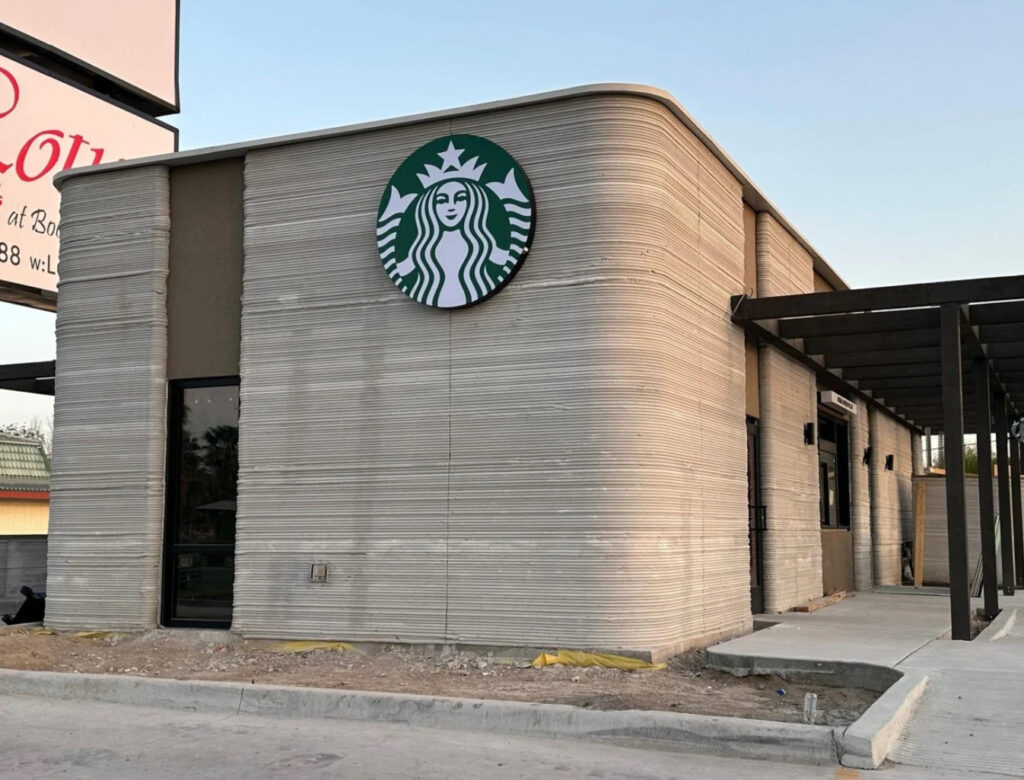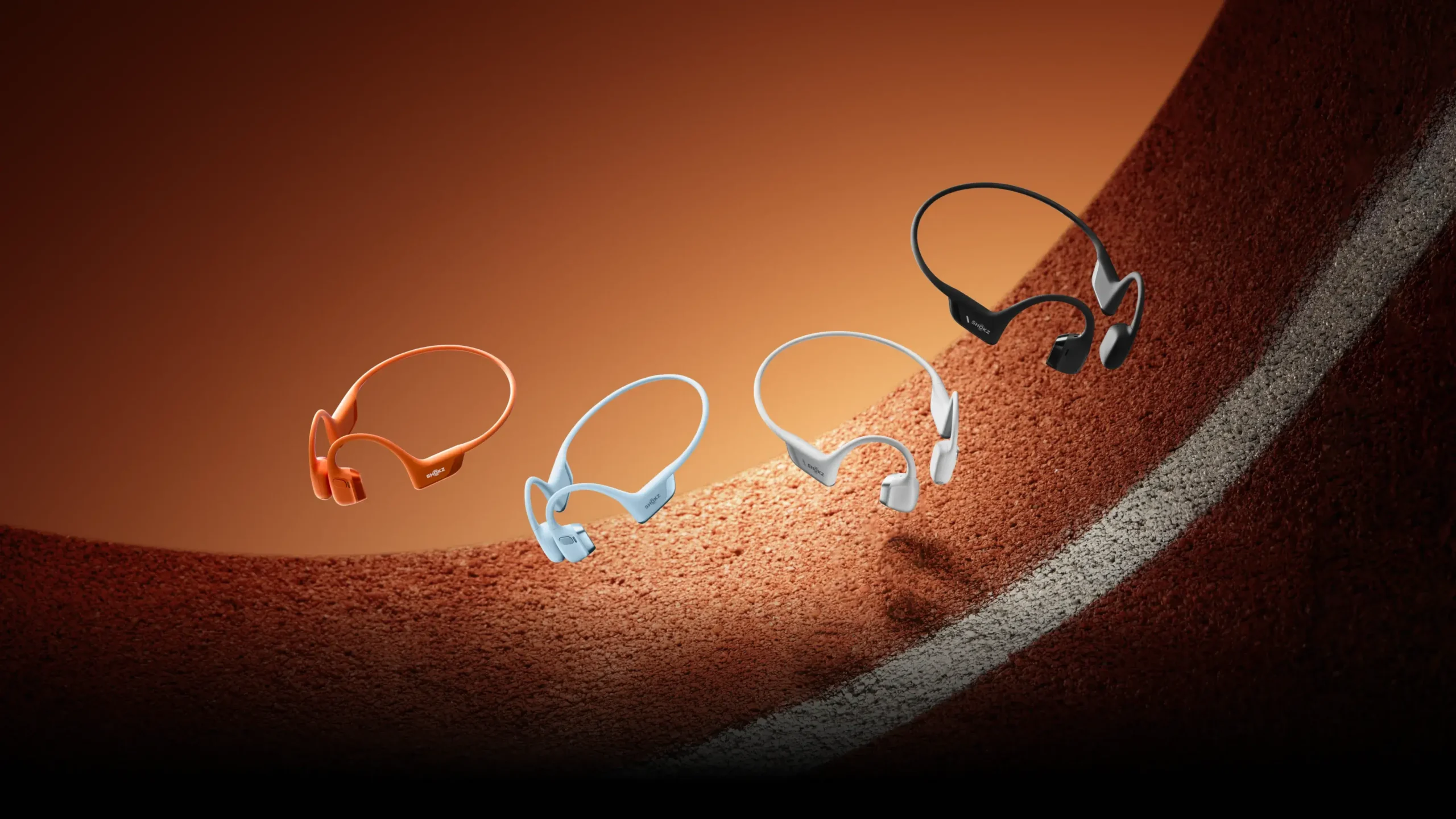It’s fitting, almost poetic, that Starbucks—an empire built on the mass manufacture of comfort—has taken its next great leap forward by letting a robot print its latest café. Opened in Brownsville, Texas, and constructed by Peri 3D Construction using a Cobod BOD2 printer, this new 1,400-square-foot drive-thru and pickup location strips away the final human flourishes of the Starbucks mythology. There are no barristas in hand-stitched aprons, no overstuffed leather chairs to cradle you while you sip your PSL and pretend to read Proust. Instead, there is concrete. Cold, rippling, industrial concrete, layered nozzle by mechanical nozzle until a building, like a latte, is conjured from thin air.
It is brutal. It is brilliant. It is, somehow, the most honest thing Starbucks has done in years.
The Sterile Soul of Mass Production
Starbucks has long sold an illusion. The “third place” it famously offered—neither home nor work—was engineered to feel organic, cozy, lived-in. Earth-tone palettes, artisanal wall art, and regional design touches aimed to give the global juggernaut a human face. But beneath the inviting veneer, Starbucks has always operated more like a caffeine-dispensing assembly line. Drinks were whipped together with computerized brewers; syrups and roasts calculated by flavor algorithms; employee scripts polished until the human interaction resembled polite automation.
For all the hand-lettered chalkboards and jazz compilations, Starbucks has been a hyper-efficient coffee vending machine masquerading as a neighborhood café.
In Brownsville, they have dropped the mask entirely. The building, 3D-printed from industrial concrete, celebrates the mechanical heart beating beneath the lifestyle branding. It acknowledges what Starbucks truly is: a frictionless service platform designed to inject caffeine into human beings with precision and speed. In doing so, it unintentionally achieves a kind of accidental honesty, perhaps even a kind of beauty.
Printing the Future, One Layer at a Time
The technology behind the new store is as mesmerizing as it is inevitable. Built by Peri 3D Construction, the café was printed using the Cobod BOD2, one of the world’s most advanced 3D construction printers. Operating with startling efficiency, the BOD2 prints layer upon layer of specially formulated concrete in wavy striations, building walls in days rather than months. After the basic structure was printed, human crews added the “soft” elements: windows, doors, electric wiring, roofing, a porch. The end result is a shell that looks at once futuristic and primitive—an automated mud hut for the Information Age.
There is a strange visual poetry in the building itself. The printed lines are visible, almost like the rings of a tree, but instead of organic growth they chart mechanical repetition. The walls ripple with the motion of the printer head, the slight imperfections a reminder that even the machine has its idiosyncrasies. It is not beautiful in a conventional sense, but it is compelling—an artifact of industry at its most stripped down and pure.
From Third Place to No Place
Starbucks originally rose to power by offering itself as a “third place” between home and work, a neutral ground where existence could feel a little softer. But the Brownsville location doesn’t pretend to be a third place. It is, unapologetically, a fueling station.
There are no comfortable interiors to linger in. This is not a site for spontaneous conversations or studying late into the evening. It’s a drive-thru and pickup hub, a concrete intermediary between the individual and their next appointment, meeting, or errand. You pull up, you collect your fix, and you move along.
In some ways, the 3D-printed Starbucks is the architectural embodiment of the smartphone era: efficiency elevated over experience, transactions stripped of pretense. It does not waste time trying to nurture community. It does not lull the visitor into lingering. It is fast, clean, impersonal—and strangely, it feels more authentically Starbucks than any of their upholstered flagship stores in Seattle or Shanghai.
The Architecture of Honesty
The choice to use 3D printing for construction is not merely an exercise in tech bravado. It represents a seismic shift in how we conceive of space, labor, and the built environment.
3D-printed architecture promises faster construction times, lower material waste, and the ability to design forms previously impossible or cost-prohibitive with traditional methods. In the case of Starbucks, it also eliminates certain aspects of human labor—no bricklayers, no carpenters, no intricate custom details carved by hand.
There is something almost dystopian in the efficiency. The robot does not tire. It does not strike. It does not make mistakes out of boredom or exhaustion. It simply builds, tirelessly and indifferently, whatever it has been programmed to produce.
The result is a building that feels paradoxically sterile and radical. Sterile because of its uniformity and mechanical birth; radical because it forces us to confront the real future of architecture: one where the warmth of handcraft gives way to the cool logic of algorithms.
The New Brutalism
There is an undeniable echo of Brutalism in the Brownsville Starbucks—not the marble-clad Brutalism of officialdom, but a new, digitized Brutalism. Like the concrete monoliths of the 1960s, this 3D-printed café rejects ornamentation. It glorifies materiality, weight, and unembellished form.
But whereas traditional Brutalism often spoke to collective civic aspirations (think government buildings, libraries, social housing), the new 3D-printed Brutalism is corporate and transactional. It builds not to house communities, but to serve customers. It prints not utopian dreams, but supply-chain nodes.
The Brownsville café is a microcosm of this shift: architecture not as a backdrop for public life, but as an interface for streamlined consumption.
Efficiency as Aesthetic
If there is beauty in the Brownsville Starbucks, it lies in the unapologetic celebration of efficiency. Every inch of the store is optimized for throughput. The building itself was printed faster than a traditional construction project would have been framed. Its small footprint and minimal interior minimize heating and cooling costs. Its drive-thru lanes maximize volume without encouraging congregation.
This is architecture as user interface: a machine that facilitates transactions quickly, cleanly, and without sentimentality.
In a broader cultural sense, the 3D-printed Starbucks points to the increasing convergence of architecture and software. As buildings are increasingly designed by algorithms, constructed by machines, and optimized for specific user behaviors, they cease to be static monuments and become dynamic infrastructures, evolving based on feedback loops of efficiency.
What We Gain, What We Lose
The Brownsville Starbucks is an achievement. It showcases the incredible possibilities of 3D construction technology. It hints at a future where affordable housing, disaster relief structures, and civic spaces could be printed swiftly and sustainably.
But it also raises uncomfortable questions about the kind of environments we are creating. If we strip away all the friction—if we optimize every experience to its most efficient version—what do we lose? What happens when even the buildings around us no longer invite contemplation, lingering, or human error?
The 3D-printed Starbucks does not invite you to stay. It does not reward curiosity. It does not inspire wonder. It fulfills a need and sends you on your way. It is a marvel of function—but perhaps a warning for those who believe that efficiency alone is enough to nourish a human spirit.
A Monument to Our Moment
In Brownsville, Texas, a robot printed a Starbucks café. People drive up, order their coffee, and drive away, barely noticing that the walls around them were squeezed into existence like toothpaste. It is hilarious. It is awe-inspiring. It is deeply, weirdly appropriate.
Starbucks, which once built an empire selling an illusion of slowness and conviviality, has finally constructed a building that mirrors its true soul: a fast, frictionless service provider designed to meet consumer needs with mechanical regularity.
The Brownsville location is not the death of Starbucks’ “third place” dream. That dream had been dying for years, quietly, incrementally, as mobile orders, drive-thrus, and loyalty apps took precedence. The 3D-printed café merely acknowledges the reality that was already here.
In doing so, it gives us a glimpse into the future of architecture, labor, and human experience. It is a small building, but a monumental statement: In a world that worships efficiency, the future will be printed, not built.
No comments yet.









